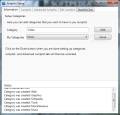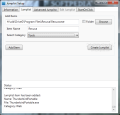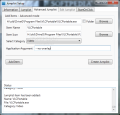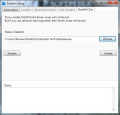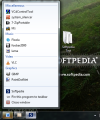Seven Jump is a mix between an application launcher and Windows 7's Jump List feature. The application allows you to create jump lists with whatever items you want. The principle it follows is simple: create a taskbar element which encompasses in its jump-list menu the items you need.
Windows 7 has increased the functionality of the desktop manifold, thus boosting your productivity considerably. The taskbar in general and jump lists in particular lead to an improved experience and easier access to web locations, documents, pictures or music you turn to on a daily basis.
Seven Jump extends the possibilities of Windows 7's taskbar jump-lists to pinning shortcuts of any program or computer location you need in a simple element attached to the taskbar. Moreover, you can break them down in categories to make them even easier to access.
In order to start using the program after you download the package and unzip it you have to define the location where you want to save the file that stores your jump list. This can be done easily by following the instructions JumpStart.exe makes available when double tapped.
The guiding in this screen includes the storage location of the jump-list you want to create, giving it a name as well as an icon. All the fields are greyed out at the beginning because you have to take everything one step at a time. At the end of the entire process you can create a shortcut file for the jump list and put it on the desktop, although pinning it to the taskbar seems like a better choice.
Each list comes with its own application window, which is reduced to just three functions: taking a screenshot of the computer screen, accessing the setup window for customizing the list and closing the list. Although it is quite unclear why the developer would include a screen capture function in the program, you can use it to save snapshots in PNG format; there is no configuration available so all you can do is click on the capture button and save the resulting PNG file on the computer.
Populating any created list with the items you need easy access to is an easy job and getting from one step to another is similar to the process of creating and saving a jump list as you are not allowed to stray to a different customization screen until you are done with the current one. First and foremost you have to create at least a category to fit the items in. all the details are visible in the lower part of the screen. As there is no “undo” button available, reverting any wrongdoing can be done by editing this log manually.
Still on the downside, once you create a jump list there is no possibility to edit it. If you access its setup screen everything will look as if you were creating the list for the first time and all modifications will replace the old configuration with no warning.
Seven Jump makes available two ways to build a jump list. One method is for the regular user and it involves simply defining the path to the item you want to launch (folders are supported); the name is automatically typed in and you can modify it.
The other way is reserved for advanced users and besides adding the path to the element you want to launch and defining its name, it also sports options for assigning an icon (supported formats: ICO and EXE), as well as adding application arguments for a customized launch.
One glitch you have to take into consideration is that a list has to be created either in “Jumplist” or “Advanced Jumplist” tab. If you try to add elements in the first one and continue adding them in the next Seven Jump will crash when “Create Jumplist” button is pressed, causing you to start the entire customization process all over.
In lack of proper documentation, the purpose of the last tab in Seven Jump's configuration window was not quite clear to us. Though we did observe that adding a path in StartOnClick causes the jump list to open that location/item (thus acting as a shortcut), we missed its functionality.
If you go past the glitches and the sort of uncomfortable way to build a list, Seven Jump makes for a great way to create custom jump lists which mimic Windows 7's feature perfectly. The advantage of this application is that the jump list file can hold the shortcuts organized into categories, thus providing better access.
Populating the lists is done in a pretty uncomfortable manner as the options are unlocked gradually; but this can also be of help to beginner users, despite the fact that handling the program is quite a breeze.
The Good
The Bad
The Truth
 14 DAY TRIAL //
14 DAY TRIAL // 

